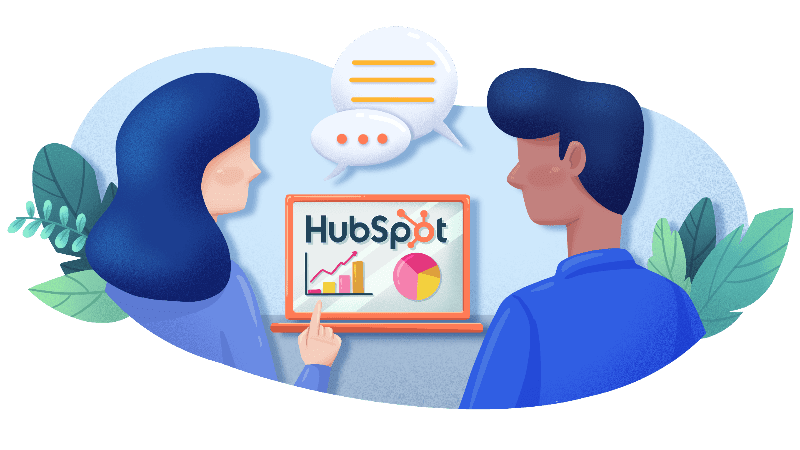Maximizing Your E-commerce Potential: HubSpot Shopify Integration Tips
It can be challenging to juggle your marketing and e-commerce efforts without the right help, so where do you turn to? With the HubSpot Shopify integration, you can unify your data, automate campaigns, and manage leads like a pro.


Why Integrate HubSpot and Shopify?
HubSpot Shopify integration is a practical and strategic solution for e-commerce businesses seeking operational efficiency and enhanced customer engagement. HubSpot, recognized for its marketing automation and CRM tools, seamlessly collaborates with Shopify, a user-friendly e-commerce platform. This integration offers tangible advantages without resorting to exaggerated claims.
Combined Strengths
HubSpot and Shopify, each a robust entity in its own right, contribute distinct strengths that, when integrated, create a harmonious workflow. HubSpot's marketing automation and CRM capabilities complement Shopify's e-commerce functionality, providing a unified system for managing diverse aspects of the business.
E-commerce Solutions
The integration goes beyond mere collaboration; it offers practical solutions to the complex needs of modern e-commerce. Businesses can streamline operations efficiently by bridging the gap between marketing and sales processes. This comprehensive approach ensures that the e-commerce ecosystem operates cohesively, from lead generation to order processing and customer support.
Enhanced Customer Experience
A notable advantage of HubSpot Shopify integration is its capacity to provide a consolidated view of customer data. This 360-degree perspective facilitates a more nuanced understanding of customer behavior, allowing businesses to tailor their approaches accordingly. Personalized marketing strategies and product recommendations become more achievable, contributing to an improved, unified, enhanced customer experience.
Operational Efficiency
The integration simplifies marketing campaigns by allowing businesses to leverage HubSpot's marketing automation tools within the Shopify environment. This practical application extends to targeted campaigns, such as addressing abandoned carts or deploying personalized promotions based on customer behavior. The result is an increase in the effectiveness of marketing efforts without relying on exaggerated imagery.
Now that you understand the power of integrating HubSpot and Shopify, let's discuss how to start.
Getting Started: Setting Up HubSpot Shopify Integration
1. Initiating the Integration
The first crucial step involves initiating the integration process between HubSpot and Shopify. Start by logging into both platforms and accessing the integration settings. HubSpot provides a dedicated app marketplace where you can find the Shopify integration. Follow the step-by-step instructions provided by both platforms to establish the connection.
-
Log in to HubSpot and Shopify: Log into your HubSpot and Shopify accounts using your respective credentials.
-
Access HubSpot App Marketplace: Navigate to the HubSpot App Marketplace. You can usually find this in the main menu of your HubSpot dashboard.
-
Find Shopify integration: Search for the Shopify integration within the HubSpot App Marketplace. Once located, click on it to access the integration details.
-
Install the integration: Follow the installation instructions provided by HubSpot. This typically involves clicking a button to initiate the installation process. Confirm any permissions or access requests.
This straightforward process lays the foundation for a seamless collaboration between your e-commerce and marketing tools.
2. Configuring Settings
After the initial setup, take the time to configure integration settings according to your business requirements. Customize settings to ensure data flows seamlessly between HubSpot and Shopify, aligning with your unique workflows.
-
Configure integration settings: After installation, you'll likely need to configure the integration settings. Customize these settings based on your business needs. This may include specifying which customer data should sync, setting up marketing automation triggers, and defining product and order information parameters.
-
Log in to Shopify: Navigate to your Shopify dashboard. Check for any prompts or notifications related to the HubSpot integration. Follow any additional setup steps provided by Shopify to complete the connection.
-
Test the integration: Create a test scenario to ensure data flows correctly between HubSpot and Shopify. This may involve making a sample purchase, updating customer information, or triggering a marketing automation workflow.
Tailoring these settings optimally ensures that the integration serves your specific business needs.
3. Troubleshooting Common Issues
While the integration process is generally smooth, preparing for potential challenges is essential. Typical issues may include data syncing errors, update delays, or configuration conflicts. Familiarize yourself with the troubleshooting resources provided by both HubSpot and Shopify to address these issues promptly. Regularly check for updates from both platforms, as software enhancements often include fixes for common integration challenges.
Need help with how to migrate your CRM?
4. Regular Maintenance
Perform regular maintenance to ensure sustained performance. Review and update integration settings as needed, especially if there are changes in your business processes. Stay informed about software updates from both platforms and apply them promptly.
Now that you understand how to integrate these two platforms let’s dive deeper into what this integration can mean for your business.
Maximize Your Integration
Leveraging Customer Data for Personalization
The integration of HubSpot and Shopify becomes a catalyst for unlocking the full potential of customer data. HubSpot Shopify integration allows businesses to consolidate customer data from both platforms, providing a comprehensive view of each customer's journey. By merging information on purchasing history, preferences, and interactions, businesses gain valuable insights into individual customer behavior.
With a deeper understanding of customers, businesses can tailor their marketing strategies precisely. HubSpot's marketing automation tools, when integrated with Shopify, enable the creation of targeted campaigns based on customer segments. From personalized product recommendations to exclusive offers, businesses can deliver content that aligns with each customer's preferences, increasing the likelihood of engagement and conversion.
Integrated customer data allows businesses to craft seamless and personalized customer journeys. Automation workflows triggered by specific customer actions on Shopify, such as a purchase or abandoned cart, can seamlessly sync with HubSpot's capabilities. This ensures that customers receive timely and relevant communications at different touchpoints, fostering a cohesive and personalized experience throughout their journey.
Streamlined Marketing Campaigns
HubSpot Shopify integration offers a unified platform for managing various marketing channels. From email in HubSpot to social media and beyond, businesses can streamline their marketing efforts by centralizing control and gaining a comprehensive view of campaign performance. This cohesion ensures consistent messaging and a more integrated approach to customer engagement.
The integration empowers businesses to harness HubSpot's robust marketing automation capabilities within the Shopify environment. Automated workflows can be seamlessly initiated based on customer behaviors, such as abandoned carts or completed purchases. This saves time and enables businesses to deliver timely and personalized communications, significantly improving the effectiveness of marketing campaigns.
With HubSpot Shopify integration, businesses can integrate their email marketing efforts seamlessly. Targeted email campaigns can be created based on customer segments and behaviors, leveraging the integrated data to deliver personalized content. The integration ensures a synchronized and efficient email marketing strategy, whether promotional emails, product recommendations, or order confirmations.
The integration extends its benefits to social media marketing, allowing businesses to synchronize their efforts across platforms. HubSpot's social media tools can schedule posts, track engagement, and even integrate social media interactions into customer profiles, providing a holistic view of customer engagement across channels.
Enhanced Customer Experience
HubSpot Shopify integration streamlines the order and shipping processes, providing a more seamless customer experience. Automated updates on order status, shipping confirmations, and delivery notifications can be effortlessly managed within the integrated environment. This reduces manual workload and keeps customers informed and engaged throughout the purchase journey.
The integration extends its benefits to customer support, allowing businesses to implement efficient query resolution and issue management tools. With integrated customer data readily available, support teams can access comprehensive information about a customer's purchase history and interactions. This enables more personalized and effective customer support, ultimately contributing to a positive overall experience.
Efficiently handling returns and refunds is a critical aspect of customer experience. With HubSpot Shopify integration, businesses can manage these processes seamlessly. Automation can initiate return workflows, update customers on refund status, and maintain clear communication throughout the process, contributing to a hassle-free customer experience.
Data-Driven Decision Making
HubSpot Shopify integration provides businesses with a consolidated pool of analytics, encompassing customer behavior, sales trends, and marketing performance. Leveraging these integrated analytics allows for a comprehensive understanding of the e-commerce landscape. Businesses can analyze data patterns, identify key trends, and derive actionable insights that form the foundation for informed business strategies.
The integration allows businesses to extract valuable insights by combining data from HubSpot's marketing and CRM tools with Shopify's e-commerce data. By examining this integrated data, businesses can gain a holistic view of customer interactions, purchase behaviors, and marketing campaign effectiveness. This deep dive into integrated data sets facilitates a nuanced understanding of customer journeys and provides a solid basis for strategic decision-making.
With data-driven insights, businesses can make informed choices to optimize their e-commerce operations. This may include refining marketing strategies based on customer engagement data, adjusting product offerings in response to sales trends, or enhancing customer support workflows based on common issues identified through integrated data. Each decision is grounded in thoroughly analyzing the integrated data sets, ensuring a proactive and strategic approach to operational optimization.
Unleash E-commerce Success with HubSpot Shopify Integration
In the dynamic landscape of e-commerce, the HubSpot Shopify integration emerges as a transformative force, providing businesses with a strategic edge to maximize their online potential. As we explored the various facets of this integration journey, from setting up seamless connections to leveraging customer data and streamlining marketing efforts, it became evident that the synergy between HubSpot and Shopify is more than a technical integration—a catalyst for unparalleled business growth.
Harness the power of HubSpot Shopify integration, and embark on a journey where every data point, marketing campaign, and customer interaction propels your e-commerce potential to new heights. Stay connected, stay integrated, and stay ahead in the world of e-commerce excellence.
This content is also available in:
- Deutsch: E-Commerce-Potenzial maximieren: HubSpot & Shopify Integration
- Español: Integración de Shopify y HubSpot: Potencia tu Comercio Electrónico
- Français: Intégration HubSpot & Shopify : Conseils pour votre E-commerce
- Italiano: Integrazione HubSpot & Shopify: Consigli per il tuo e-commerce
- Română: Integrarea HubSpot & Shopify: Sfaturi pentru succes în E-commerce
- 简体中文: 最大限度地发挥电子商务潜力:HubSpot Shopify 整合技巧








Leave a Comment